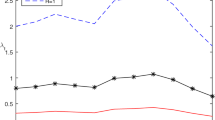Abstract
We study a Bayesian–Nash equilibrium model of insider trading in continuous time. The supply of the risky asset is assumed to be stochastic. This supply can be interpreted as noise from nonrational traders (noise traders). A rational informed investor (the insider) has private information on the growth rate of the dividend flow rewarded by the risky asset. She is risk averse and maximizes her inter-temporal utility rate over an infinite time-horizon. The market is cleared by a risk neutral market maker who sets the price of the risky asset competitively as the conditional present value of future dividends, given the information supplied by the dividend history and the cumulative order flow. Due to the presence of noise traders, the market demand does not fully reveal the insider’s private information, which slowly becomes incorporated in prices. An interesting result of the paper is that a nonstandard linear filtering procedure gives an a priori form for the equilibrium strategy to be postulated. We show the existence of a stationary linear equilibrium where the insider acts strategically by taking advantage of the camouflage provided by the noise which affects the market maker’s estimates on private information. In this equilibrium, we find that the insider’s returns on the stock are uncorrelated over long periods of time. Finally, we show that the instantaneous variance of the price under asymmetric information lies between the instantaneous variance of the price under complete and incomplete information. The converse inequalities hold true for the unconditional variance of the price.
Similar content being viewed by others
References
Anderson B.D.O., Moore J.B.: Optimal Filtering. Prentice-Hall, New Jersey (1979)
Back K.: Insider trading in continuous time. Rev. Financ. Stud. 5, 387–409 (1992)
Back K., Cao H., Willard G.: Imperfect competition among informed traders. J. Finance 55, 2117–2155 (2000)
Back K., Pedersen H.: Long lived information and intraday patterns. J. Financ. Mark. 1, 385–402 (1998)
Campbell J.Y., Kyle A.S.: Smart money, noise trading and stock price behaviour. Rev. Econ. Stud. 60, 1–34 (1993)
Chau M., Vayanos V.: Strong-form efficiency with monopolistic insiders. Rev. Financ. Stud. 21, 2275–2306 (2008)
Fama E.: Efficient capital markets: a review of theory and empirical work. J. Finance 25, 383–417 (1970)
Fleming W.H., Rishel R.W.: Deterministic and Stochastic Optimal Control. Springer, New York (1975)
Foster D., Viswanathan S.: Strategic trading when agents forecast the forecasts of others. J. Finance 51, 1438–1447 (1996)
Grossman S.J.: The existence of futures markets, noisy rational expectations equilibrium and information externalities. Rev. Econ. Stud. 44, 431–449 (1977)
Grossman S.J.: An introduction to the theory of rational expectations under asymmetric information. Rev. Econ. Stud. 48, 541–559 (1981)
Holden C., Subrahmanyan A.: Long-lived private information and imperfect competition. J. Finance 47, 247–270 (1992)
Kyle A.S.: Continuous auctions and insider trading. Econometrica 53, 1315–1335 (1985)
Kyle A.S.: Informed speculation with monopolistic competition. Rev. Econ. Stud. 56, 317–355 (1989)
Liptser R.S., Shiryayev A.N.: Statistics of Random Processes I. Springer, New York (2001)
Merton R.C.: Optimum consumption and portfolio rules in a continuous time model. J. Econ. Theory 3, 373–413 (1971)
Milgrom P., Stokey N.: Information, trade and common knowledge. J. Econ. Theory 26, 17–27 (1982)
Wang J.: A model of intertemporal asset prices under asymmetric information. Rev. Econ. Stud. 60, 249–282 (1993)
Author information
Authors and Affiliations
Corresponding author
Rights and permissions
About this article
Cite this article
Monte, R., Trivellato, B. An equilibrium model of insider trading in continuous time. Decisions Econ Finan 32, 83–128 (2009). https://doi.org/10.1007/s10203-009-0093-8
Received:
Revised:
Accepted:
Published:
Issue Date:
DOI: https://doi.org/10.1007/s10203-009-0093-8



